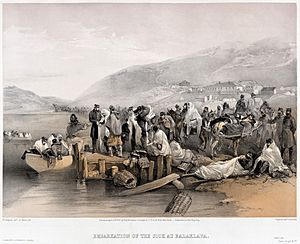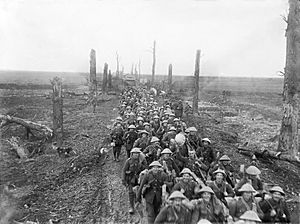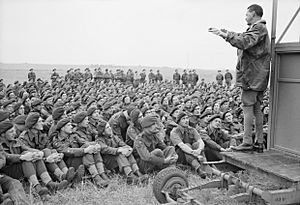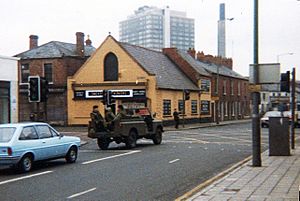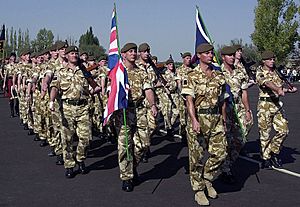History of the British Army facts for kids
The history of the British Army goes back over 350 years, starting in 1660. It has been involved in many important wars, including conflicts in Europe, colonial wars, and both World Wars. For a long time, from the late 1600s to the mid-1900s, the United Kingdom was the most powerful country economically and had a huge empire. While the Royal Navy (the navy) was key to this, the British Army played a big part too.
As of 2015, the British Army had about 92,000 full-time soldiers, including 2,700 Gurkhas. It also had about 20,480 Volunteer Reserves. Britain usually keeps a small regular army during peacetime. It makes the army bigger only when there's a war. This is because Britain has always been a strong sea power. Since 1745, the British Army has not been very involved in British politics, except for a few rare times when it was used to handle problems inside the country.
The British Army has fought in many international conflicts. These include the Napoleonic Wars, the Crimean War, and both World War I and World War II. In the past, it helped expand and keep hold of the British Empire.
The British Army has often been at the forefront of new military ideas. It was the first in the world to create and use the tank. Also, the Royal Air Force (RAF), which is Britain's air force today, started within the British Army as the Royal Flying Corps (RFC). At the same time, the British Army values its long history and traditions.
Contents
- How the British Army Started
- How the British Army Was Formed
- The British Army in the 1700s
- The Seven Years' War (1755–1763)
- The American War of Independence (1775–1783)
- The Napoleonic Wars (1793–1815)
- The Later 1800s
- First World War (1914–1918)
- Between the World Wars (1919–1939)
- Second World War (1939–1945)
- End of Empire and Cold War (1945–1990)
- The British Army: 1990–Present
- See also
How the British Army Started
The English Army officially began as a standing army (a permanent army that exists even in peacetime) in 1660. By 1707, many English and Scottish army groups were already working together. They were fighting in the Dutch Republic during the War of Spanish Succession. When the new British Army was formed, these groups joined it, bringing their customs and traditions with them.
Some historians believe the army's roots go back even further than 1660. They point to the New Model Army, which was created in 1645. This was the first full-time professional army in England, Ireland, and Scotland. It was very successful in battles like Naseby and Dunbar.
The New Model Army was so strong that it survived attempts by Parliament to break it up. Even though many groups turned against it, the army won. It continued to be important during the time when England had no king (the Interregnum). However, it was disbanded in 1660 when Charles II became king again.
When Charles II returned to the throne, he wanted to create a small standing army. He included some soldiers who had fought for him when he was in exile. He also wisely included some parts of the New Model Army. On January 26, 1661, Charles II issued a special order that created the first regiments of what would become the British Army. However, Scotland and England still had separate military forces until 1707.
Many people in England were worried about the king creating a permanent army. They remembered a time when military rule was imposed and they didn't like it. They also feared that a standing army would allow future kings to ignore what Parliament wanted.
The English people didn't fully accept the need for a standing army until the time of William III. Constant wars with other European countries made a small standing army necessary to defend England and keep its power in the world. Parliament eventually gained control over the army through a law called the Mutiny Act. This law set limits on the king's power over the army. It made sure that the army could only exist if Parliament approved it every year. Even today, the British Army needs an annual act of Parliament to remain legal.
How the British Army Was Formed
The order of importance for the oldest regiments in the British Army is based on their rank in the English army. Scottish and Irish regiments were only given a rank in the English army from the date they arrived in England or were first added to the English system. For example, a group that became known as the Scots Greys was first called the 4th dragoons. This was because three English regiments were formed before the Scots Greys were added to the English system in 1688. Later, in 1713, the Scots Greys' rank was changed. They became the 2nd dragoons in the British Army because there was only one English regiment of dragoons when they first came to England in 1685.
The British Army in the 1700s
How the Army Was Organized
By the mid-1700s, the army's management had taken a shape that would last for over a hundred years. The main groups in charge of the army were:
- The War Office: This group handled the daily running of the army, including the cavalry (soldiers on horseback) and infantry (soldiers on foot).
- The Board of Ordnance: This group was in charge of providing weapons and ammunition. It also managed the Royal Artillery (cannons) and Royal Engineers (building and engineering).
- The Commissariat: This group was responsible for food supplies and transport.
These groups usually weren't part of the main government cabinet. The overall strategy was handled by the Secretary of State for War.
In the field, a commander had a team of helpers. An Adjutant General dealt with money, troop records, and legal matters. A Quartermaster General was in charge of housing soldiers and organizing their movements. There were also separate commanders for the Artillery and officers for supplies.
Infantry and cavalry units were first known by their colonels' names, like "Sir John Mordaunt's Regiment of Foot." This could be confusing. So, in 1751, a number system was adopted. Each regiment got a number based on its rank. For example, John Mordaunt's Regiment became the 47th Regiment of Foot.
The Jacobite risings (rebellions to bring back the Stuart kings) mainly happened in the Scottish Highlands. To keep order, the government formed Independent Highland Companies from clans that supported the king. In 1739, the first full regiment, the 42nd Regiment of Foot, was formed in this area.
By the end of the 1700s, the battalion became the main fighting unit. In Britain, a regiment was more about administration than fighting. Many regiments had only one battalion. If more soldiers were needed for a war, second or third battalions were created.
Army Strategy and Role
From the late 1600s onwards, the British Army was used in three main areas: the Americas, Europe, and Scotland. The conflict in Scotland largely ended after the Battle of Culloden in 1746. Europe was often the main battleground. British kings had family ties to countries like Holland or Hanover. Also, Britain's foreign policy often required it to step in to keep a balance of power in Europe, usually against France.
In England and especially Scotland, the exiled Stuart family and their Jacobite supporters tried many times to get the throne back. These rebellions were often linked to European conflicts, as Britain's enemies helped the Stuarts. After the Battle of Culloden in 1746, these rebellions were crushed.
As the British Empire grew, the army was increasingly sent to places like the West Indies, North America, and India. Soldiers were often recruited locally to help. Sometimes these local forces were part of the British Army, like the 60th (Royal American) Regiment of Foot. Other times, like with the British East India Company's troops, they were separate but worked with the British Army.
Soldiers sent overseas often served for years in difficult climates, far from home. This meant the army often recruited the poorest or least well-behaved people. The red-coated soldier was often looked down upon, as the poem "Tommy" by Rudyard Kipling describes.
The Seven Years' War (1755–1763)

The Seven Years' War, from 1755 to 1763, is sometimes called the first true world war. This is because fighting happened on almost every continent and ocean. Even though Britain faced some early problems, its troops eventually won in every area.
The war began in North America, where it was known as the French and Indian War. In the early years, Britain suffered several defeats. British soldiers sent there first were not trained for fighting in the forests. To create light infantry, groups like Rogers' Rangers were formed from the colonists.
There were also disagreements between high-ranking British officers and the local troops from the colonies. British officers were always in charge, even if they were younger than colonial officers. The colonists cared most about protecting settlers from Native American attacks, while British generals often had different plans. Thanks to the Royal Navy's control of the seas, Britain was able to send more forces to North America. They won the important Battle of the Plains of Abraham at Quebec City and took over New France.
In India, the French and the armies of powerful Indian rulers were defeated after a long war. This allowed the British East India Company to steadily expand its control. In Europe, British troops played an important role in the decisive Battle of Minden.
What Happened After the War
This war made the British Empire the main power in North America. Britain controlled all European land east of the Mississippi River. After the war, there was growing tension between the British government and the American colonists. This was especially true when Britain decided to keep a standing army in North America during peacetime for the first time.
With France defeated, the British government no longer tried as hard to gain the favor of Native Americans. General Jeffery Amherst, trying to save money, made changes that helped cause Pontiac's War in 1763. This was an uprising against the British military taking over former French lands.
The American War of Independence (1775–1783)
The American Revolution started because King George III tried to keep a permanent army in British America. He also tried to tax the colonies to pay for this army. The colonists in the Thirteen Colonies disliked both the idea of a "standing army" and "taxation without representation" (being taxed without having a say in Parliament). They began to argue that the British Parliament should not have power over them.
For the British Army, the American War of Independence began with the military occupation of Boston in 1768. Tensions between the army and local people led to the Boston Massacre in 1770. Full-scale war didn't start until 1775. That's when colonial militias called "Minutemen" attacked a British army group sent to take colonial weapons.
More soldiers were sent to America to stop what was expected to be a quick rebellion. However, in July 1776, the Second Continental Congress declared the colonies' independence as the United States. Because the British army was small at the start of the war, the British government hired soldiers from several German states, often called "Hessians." As the war went on, Britain also tried to recruit Loyalist soldiers (Americans who supported the British).
The war ended in 1783. The British government had to accept its defeat and the independence of the U.S. under the Treaty of Paris. Many Loyalists moved north to British Canada. Most British units formed during the war were disbanded right after it ended.
The Army had to change its fighting methods for North America's poor communication and forested land. They created many light infantry units and changed their strict drills to a more flexible style. While the British won most major battles, these victories were not decisive. British defeats at the Battle of Saratoga and Siege of Yorktown hurt British morale and power. Historians have looked at why Britain lost, considering issues like communication, supplies, unclear goals, and underestimating the American forces.
The Napoleonic Wars (1793–1815)
The British Army changed a lot during the French Revolutionary and Napoleonic Wars. In 1793, at the start of the French Revolutionary Wars, the army was small, with only about 40,000 men, and poorly managed. By the end of the Napoleonic Wars, the army had gone through many changes in its structure, how it recruited soldiers, its tactics, and its training. Its number of soldiers had greatly increased. At its largest, in 1813, the regular army had over 250,000 men. The British infantry was known for being "the only military force not to suffer a major reverse at the hands of Napoleonic France."
The Later 1800s
During the long reign of Queen Victoria, British society changed a lot. The Industrial Revolution brought new technologies, and Britain made many liberal reforms. This time was also when the British Empire steadily grew. The army's job was to defend the Empire and control local populations. The Industrial Revolution changed the army's weapons, transport, and equipment. Social changes, like better education, led to changes in how soldiers served. However, the army still kept many features from the time of the Duke of Wellington. Because its main job was to maintain the growing British Empire, it was different from the conscripted armies of Europe. For example, it didn't do large-scale training exercises very often.
The Crimean War (1854–56) had many mistakes and failures. The most famous was the "Charge of the Light Brigade," a very bad decision. This war became a symbol of problems with supplies, medical care, and management. The public in Britain was angry about how traditional methods failed when other parts of British society were modernizing. Newspapers demanded big changes, and investigations in Parliament showed many serious problems. However, the efforts to reform the army were not well organized. This allowed the traditional leaders of the army, who were often from rich families, to stop any major changes. No one was punished. The start of the Indian Rebellion of 1857 then shifted attention to the army's heroic defense of British interests, and talk of reform stopped. However, Florence Nightingale became famous worldwide for her work in modern nursing while treating the wounded, which helped professionalize care.
Army Reforms
The Crimean War showed that changes were urgently needed to make sure the Army could protect Britain and its Empire. However, major reforms didn't happen until the 1870s. Prime Minister William Ewart Gladstone didn't focus much on military matters, except for budgets. But when he and the rest of Europe saw Germany quickly defeat France in the Franco-Prussian War, the many old weaknesses of the British army became clear. His Secretary of State for War, Edward Cardwell, suggested big changes that Gladstone pushed through Parliament. The German system of professional soldiers with modern weapons was much better than Britain's traditional system of "gentlemen-soldiers." The Cardwell Reforms put more power in the War Office. They stopped officers from buying their positions and created reserve forces in Britain by having shorter service times for enlisted men.
Edward Cardwell (1813–1886) was the Secretary of State for War from 1868 to 1874. He designed the reforms that Gladstone supported. In 1868, he stopped flogging (whipping) soldiers, which made being a private soldier more respected. In 1870, Cardwell stopped giving "bounty money" to new recruits and removed bad characters from the army. He also pulled 20,000 soldiers out of self-governing colonies like Canada, making them responsible for their own defense.
The most important change was stopping the system where officers bought their ranks and promotions. This system meant that rich land-owning families controlled all the middle and senior ranks in the army. Promotion depended on a family's wealth, not an officer's skill. Middle-class people were almost completely shut out. British officers were expected to be gentlemen and good at sports. It didn't matter if they lacked military knowledge or leadership skills. Some people worried that professional experts might threaten the ruling class. But Germany's unification made this old-fashioned policy too risky for a great empire. The bill to end the purchase system passed the House of Commons in 1871 but was blocked by the House of Lords. Gladstone then forced the Lords to approve the original bill. Liberals supported Gladstone's anti-elitism. They pointed to Lord Cardigan, who spent £40,000 for his position and was very bad at his job in the Crimean War. He ordered the disastrous "Charge of the Light Brigade" in 1854.
Cardwell also reorganized the war department. He made the Secretary of State for War more powerful than the Army's Commander in Chief, who was Prince George, the Queen's cousin and against the reforms. The militia was also reformed and became part of the Army. The time soldiers had to serve was shortened to 6 years. This meant more soldiers left and became trained reservists. The system of recruiting for regiments was standardized. Cardwell reduced the army budget but still increased its strength by 25 battalions, 156 field guns, and many supplies. The number of reserves available for foreign service grew tenfold.
First World War (1914–1918)
The British Army in World War I had changed a lot due to the growing demands of the empire and problems seen in the Crimean War. This led to the Cardwell and Childers Reforms in the late 1800s, which gave the British Army its modern shape and regimental system. The Esher Report in 1904 suggested big changes, like creating an Army Council and a General Staff. The Haldane Reforms in 1907 created an expeditionary force of seven divisions. It also reorganized volunteers into a new Territorial Force and changed the old militia into a special reserve.
At the start of World War I in August 1914, the British Army was different from the French and German armies. It was made up of volunteers, not soldiers forced to join (conscripts). It was also much smaller. The British entry into World War I tested the Haldane reforms. The British Expeditionary Force (BEF) of six divisions was quickly sent to Europe. The Territorial Force and Reserves were called up to provide more soldiers.
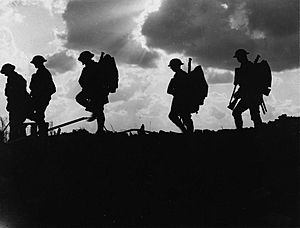
During the war, there were three main British Armies. The 'first' army was the small volunteer force of about 400,000 soldiers. More than half of these were sent overseas to guard the British Empire. This group, known as the Old Contemptibles, served in France. The 'second' army was Kitchener's Army, made up of volunteers from 1914–1915. These soldiers first saw action at the Battle of the Somme. The 'third' army was formed after conscription (forcing people to join the army) started in January 1916. By the end of 1918, the British Army had grown to four million men and could field over seventy divisions.
The war also saw new weapons and equipment. The Maxim machine gun was replaced by better, lighter Vickers and Lewis machine guns. The Brodie helmet was given to soldiers for better protection against shrapnel. The Mark I tank was invented to try to break the deadlock of trench warfare.
Most of the British Army fought in France and Belgium on the Western Front. But some units also fought in the Mediterranean, the Middle East, Africa, and Mesopotamia, mainly against the Ottoman Empire. One battalion even fought in China during the Siege of Tsingtao.
Between the World Wars (1919–1939)
How the Army Was Organized
After World War I, Britain faced serious economic problems. The government made big cuts to defense spending in the early 1920s. This was known as the "Geddes Axe." The government also introduced the Ten Year Rule, believing Britain wouldn't be in another major war for 10 years. This rule was extended until 1932.
The Royal Tank Corps (which later became the Royal Tank Regiment) was the only new group formed in World War I that survived the cuts. Other groups, like the Machine Gun Corps, were disbanded. Their jobs were taken over by specialists within infantry units. A new group, the Royal Signals, was formed in 1920 to handle communications.
Within the cavalry, sixteen regiments were combined into eight. There was also a big reduction in the number of infantry battalions and the size of the Territorial Force, which was renamed the Territorial Army. In 1922, the Army also lost six Irish regiments when the Irish Free State was created.
Until the early 1930s, the Army's main job was to act as an "imperial policeman," dealing with small conflicts across the Empire. Unfortunately, some high-ranking officers in the 1930s were not very forward-thinking. This meant that new ideas, like the Experimental Mechanized Force of 1927–28, didn't go as far as they could have.
Army Operations Between Wars
One of the first campaigns the Army took part in after the war was helping the "White Army" against the Communist Bolsheviks in the Russian Civil War in 1919. Another was the Third Anglo-Afghan War (1918–19) in Afghanistan. The British Army also kept occupation forces in the defeated countries of World War I. In Germany, a British Army of the Rhine (BAOR) was set up for the Allied occupation. This force stayed until 1929.
Throughout this period, the Army also had to deal with groups trying to remove the British. In Iraq, British forces put down the Iraqi revolt of 1920 against British rule. In British Somaliland, they fought against Diiriye Guure's men. The newly formed RAF was very important in defeating him. The Army also fought against the IRA in Ireland during the Anglo-Irish War. Both sides committed terrible acts. The British Army also supported the Indian Army in fighting hostile tribes in the North-West Frontier of British India. The last major uprising the Army dealt with before World War II was in Palestine from 1936–39.
Preparing for Another War
By the mid-1930s, Nazi Germany was becoming more aggressive. Another war with Germany seemed likely. The Army was not ready for such a war. It was far behind the technologically advanced German Army. The Army received less money than the Royal Navy and Royal Air Force.
After World War I, the Army's ideas about strategy had not changed much. While Germany quickly adopted ideas of mechanized warfare, many high-ranking British officers were not keen on armored warfare. The ideas of thinkers like Basil Liddell Hart were largely ignored.
One step the Army did take was to mechanize its cavalry, starting in 1929. This was slow at first. By the mid-1930s, mechanization was speeding up. On April 4, 1939, the Royal Armoured Corps was formed to manage the cavalry regiments and the Royal Tank Regiment. The mechanization was finished in 1941 when the Royal Scots Greys gave up their horses.
After the Munich Crisis in 1938, a serious effort was made to expand the Army. This included doubling the size of the Territorial Army and bringing back conscription in April 1939. By mid-1939, the Army had 230,000 regular soldiers and 453,000 Territorials and Reservists. However, most Territorial groups were not fully staffed or well-equipped. Even this army was still much smaller than those in Europe. Just before the war, a new British Expeditionary Force was formed. By the end of 1939, over 1 million people had been conscripted into the Army.
Between 1938 and 1939, with the army growing, new groups were formed. This included the Auxiliary Territorial Service for women in September 1938. Their duties were varied and helped free up men for fighting on the front lines.
Second World War (1939–1945)
In 1939, the British Army was made up of volunteers, but it started conscription (drafting people) just before Britain declared war on Germany. In the early years of World War II, the army lost battles in almost every place it fought. This was due to decisions made before the war and confusion among politicians and commanders about the army's role. With mass conscription, the army grew a lot. More divisions, army corps, armies, and army groups were created. From 1943, the British Army's luck changed, and it rarely suffered a major defeat.
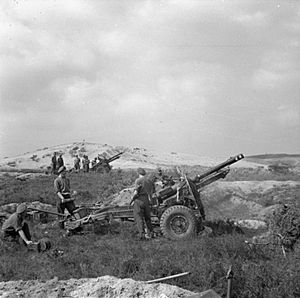
The British Army before the war was trained to guard and police the British Empire. It was not ready or well-equipped for a war against many enemies on many fronts. At the start of the war, the army was small compared to its enemies. It remained an all-volunteer force until 1939. By the end of the war, the British Army had grown to over 3.5 million soldiers.
The British Army fought all over the world. Campaigns included Norway, Belgium and France in 1940. After those countries fell, it fought in Africa, the Mediterranean and Middle East, and the Far East. After a series of problems and retreats, the British Army and its Allies eventually gained the upper hand. This started with victory over Italian and German forces in the Tunisia Campaign. Italy then surrendered after the invasion of Sicily and mainland Italy. In the last years of the war, the British Army, with its allies, returned to France. They pushed the German Army back into Germany. In the Far East, they pushed the Japanese back from the Indian border into Burma. Both the Germans and Japanese were defeated by 1945.
With the British Army growing to fight a world war, new armies and eventually army groups were formed. Eight men were promoted to the rank of field marshal to command these new armies. These commanders also had to manage new types of soldiers in special units. These included the Special Air Service, Army Commandos, and the Parachute Regiment.
End of Empire and Cold War (1945–1990)
How the Army Was Organized
The creation of North Atlantic Treaty Organization (NATO) in 1949 marked the start of the "Cold War." This was a period of tension between the "Western Allies" and the Communist countries led by the Soviet Union. The Soviet Union and its allies formed their own group, the Warsaw Pact, in 1955. A key part of NATO's defenses in Europe was the British Army of the Rhine (BAOR) in West Germany. This became the British Army's new main overseas base after India became independent. The BAOR had about 80,000 troops at its peak. In Britain, there were five regional commands, which later merged to become HQ United Kingdom Land Forces (UKLF) in 1972.
The Army began to reduce its size after the war. Territorial units were put on hold and then reformed in 1947. On January 1, 1948, National Service (a new name for conscription) officially began. However, the Army was still getting smaller as British rule ended in India and other colonies. Many regiments combined their battalions. This was a tough decision for the army, which was already stretched thin. In 1948, the Army also received four Gurkha regiments from the Indian Army. They formed the Brigade of Gurkhas and were first based in Malaya.
More changes to the armed forces happened with the 1957 Defence White Paper. This led to further reductions. The government realized after the Suez Crisis that Britain was no longer a global superpower. It decided to pull back from most of its commitments around the world. The armed forces would focus on NATO, with more reliance on nuclear weapons. The White Paper announced that the Army would be cut from about 330,000 to 165,000 soldiers. National Service ended by 1963, making the Army an all-professional force. This huge reduction meant that between 1958 and 1962, many cavalry and infantry regiments were combined.
Many of the regiments created during the 1957 changes lasted only a short time. Most were combined into new "large" regiments. Two regiments, The Cameronians (Scottish Rifles) and The York and Lancaster Regiment, chose to be disbanded rather than combined. The fourteen administrative brigades (created in 1948) were replaced by six administrative divisions in 1968. More cavalry and infantry regiments were combined between 1969 and 1971.
Post-World War II Operations Overseas
Far East
Right after World War II, the Army was tasked with taking back former British territories captured by the Japanese, like Malaya, Singapore, and Hong Kong. The British Army also briefly helped other European nations try to get back control of their South-Eastern Asian countries. For example, British and Indian Army forces were sent to Java in the Dutch East Indies in September 1945. Their job was to disarm and help send home the Japanese occupation forces. However, local nationalists had declared an independent Indonesia, and the situation was chaotic. The British and Indian forces faced strong resistance. The British even used former Japanese soldiers to help keep order. Dutch forces slowly arrived, and the British and Indians left by November 1946.
A similar situation happened in French Indochina. After Ho Chi Minh declared Vietnam's independence in September 1945, British and Indian troops were sent to occupy the south of the country. Vietnam was in chaos, and people didn't want French rule back. The British military decided to rearm French prisoners of war, who then caused trouble. British forces also rearmed Japanese troops to help keep order. The British and Indians left by February 1946, and the First Indochina War began soon after.
British Decolonization
In the late 1940s, Britain began to withdraw from its Empire, and the Army played a big part in this process. The first colony Britain left was India, its largest possession by population.
In 1947, the British government announced India would become independent on August 15. It was divided into two countries: Pakistan (mostly Muslim) and India (mostly Hindu). The British Army did not play a major role in the First Indo-Pakistani War between these two countries. The last British Army unit left India on February 28, 1948.
In Mandatory Palestine, attacks against British rule increased after Britain tried to limit Jewish immigration. British forces eventually withdrew in 1948, and the State of Israel was established on May 14.
Elsewhere, Communist fighters started an uprising in Malaya, beginning the Malayan Emergency. In the early 1950s, trouble also started in Cyprus and Kenya (the Mau Mau uprising). In Cyprus, a Greek nationalist group wanted to unite with Greece. The situation calmed down just before Cyprus gained independence in 1960.
Korean War
The British Army also took part in the Korean War (1950–53) as part of the United Nations Command. They fought in battles like Imjin River. In late 1950, when Chinese forces advanced on Pyongyang, the British Army helped supervise and protect refugees fleeing the city.
More British Decolonization
The Army withdrew from the Suez Canal Zone in Egypt in 1955. The next year, Britain, along with France and Israel, invaded Egypt in the Suez War. This happened after Egyptian leader President Nasser took control of the Suez Canal, in which British and French companies owned shares. The British Army contributed forces to the attack. This short war was a military success. However, international pressure, especially from the U.S. government, soon forced Britain to withdraw all its military forces. United Nations peacekeeping troops replaced them.
In the 1960s, the Army was heavily involved in two conflicts: the Aden Emergency and the Indonesia–Malaysia confrontation in Borneo.
Operations Within the United Kingdom
Northern Ireland
In 1969, a surge of violence in Northern Ireland led to British troops being sent in to try to stop it. This was called Operation Banner. The troops were first welcomed by the Catholic community, who thought they would protect them. However, this changed as the troops began to support the local police. The Provisional Irish Republican Army (PIRA), a new militant group, began to target British troops. The British Army was often put in a policing role, which it was not well-suited for. It tried to prevent clashes between Catholics and Protestants, stop riots, and prevent terrorist attacks.
As the PIRA's campaign grew more intense in the early 1970s, the Army found itself increasingly fighting the IRA and the Catholic community that supported it. British troops carried out several major operations. The Falls Curfew in 1971 saw over 3,000 troops impose a 3-day curfew on the Falls Road area of Belfast and fight a gun battle with local IRA men. In Operation Demetrius in June 1971, 300 suspected paramilitaries were arrested without trial. This caused a big increase in violence. The largest British operation was Operation Motorman in 1972, when about 21,000 troops were used to take back control of areas in Belfast and Derry from republican groups. The British Army's reputation suffered greatly from an incident in Derry on January 30, 1972, known as Bloody Sunday. In this event, 13 Catholic civilians were killed by The Parachute Regiment. The biggest loss of life for British troops in the conflict happened at Narrow Water, where eighteen British soldiers were killed by a PIRA bomb attack on August 27, 1979. On the same day, Lord Mountbatten was killed by the PIRA in a separate attack. In total, almost 500 British troops died in Northern Ireland between 1969 and 1997.
By the late 1970s, the British Army was less involved in frontline security. Local police and the Ulster Defence Regiment took on more responsibility. By the 1980s and early 1990s, British Army casualties dropped. British Special Forces also had successes against the PIRA. However, the conflict kept over 12,000 British troops busy until the late 1990s. It ended with the Good Friday Agreement, which set a path for a political solution.
Operation Banner ended in 2007, making it the longest continuous operation in British Army history, lasting over thirty-eight years. Troop numbers were reduced to 5,000.
England
In 1980, the Special Air Service (SAS), a secretive special forces unit, became famous. Its most public operation was ending the Iranian Embassy Siege in London, which was shown live on television. By the 1980s, even though the Army was being sent abroad more often, most of its permanent overseas bases were gone. The largest remaining one was the BAOR in Germany. Others included Belize, Brunei, Gibraltar, and Hong Kong.
The Falklands War (1982)
One remaining base was on the Falkland Islands in the South Atlantic, about 6,000 to 8,000 miles (11,000 to 15,000 km) from Britain. The Argentinians invaded the Falklands in April 1982. Britain quickly responded. The Army was very involved in the campaign to free the Falklands. After landing at San Carlos, they fought a series of battles that led them to the capital, Stanley. The Falklands War ended with the formal surrender of the Armed Forces of the Argentine Republic on June 14.
The British Army: 1990–Present
How the Army Was Organized
The collapse of the Soviet Union ended the Cold War. This led to a new defense plan called Options for Change. This plan meant cuts to the British armed forces. The Army saw a big reduction in its number of soldiers (down to about 120,000). This included more regiments combining. The British Army in Germany was also affected, with the British Army of the Rhine being replaced by British Forces Germany. Soldier numbers there were cut from about 55,000 to 25,000.
A major change was the disbandment of the Women's Royal Army Corps. Women were then integrated into services that had only been for men before. However, women were still not allowed to join armored and infantry units. The four Gurkha regiments were combined to form the three-battalion Royal Gurkha Rifles. This was reduced to two battalions in 1996, just before Hong Kong was handed over to China in 1997.
The Labour Party became the new government in 1997. After their election victory, a new defense plan called the Strategic Defence Review (1998) was created. Some of the Army's reforms included creating two deployable divisions: the 1st (UK) Armoured Division and the 3rd Mechanised Division. The 16 Air Assault Brigade was formed to give the Army more mobility. It would include the Westland WAH-64 Apache attack helicopter. Other efforts to make the Army more mobile included the Joint Rapid Reaction Force. This force was meant to react quickly to situations like the one in Bosnia.
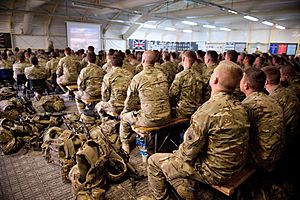
Another defense review was published in 2004, called Delivering Security in a Changing World. This plan stated that the Army's manpower would be reduced by 1,000. Four infantry battalions would be cut, and the soldiers would be moved elsewhere. One of the most radical parts of the reforms was that most single-battalion regiments would combine into large regiments. Most of the battalions would keep their old regimental names in their battalion names. The Territorial Army would also be more integrated into the regular Army.
The Army's elite units are also playing a bigger role. The SAS received more money in the 2004 defense plan, showing its growing importance in the War on Terror. Another elite unit, the Special Reconnaissance Regiment, started operating in 2005. The 1st Battalion of the Parachute Regiment became the core of a multi-service Special Forces Support Group. This group was formed in 2006 to support the SAS and the Navy's SBS. It is described as the Army's equivalent to the U.S. Army Rangers.
Recent Army Operations
The end of the Cold War did not bring peace for the British Army. The political changes led to more instability around the world. Saddam Hussein's Iraq invaded Kuwait in 1990. This led to condemnation from the United Nations, mainly led by the United States. Britain's contribution to the Gulf War, called Operation Granby, was large. The Army sent about 28,000 troops and 13,000 vehicles. After air operations, the ground war against Iraq began on February 24. The 1st Armoured Division helped destroy many Iraqi units. The ground campaign lasted only 100 hours, and Kuwait was officially freed on February 27.
The British Army has also played a growing role in peacekeeping. In 1992, during the wars in the Balkans, UN forces stepped in. British forces contributed as part of UNPROFOR (United Nations Protection Force). This force was for peacekeeping, but with no peace to keep, it was not very effective. It was replaced by NATO's Implementation Force. As of 2005, Britain's contribution was about 3,000 troops. In 1999, the UK took a leading role in the NATO war against Serbia in the Kosovo War. After the air war, the Parachute Regiment and Royal Gurkha Rifles led the ground forces entering Kosovo. In 2000, British forces intervened in the Sierra Leone Civil War to evacuate British and other citizens. The SAS also played a key role in rescuing six soldiers held by rebels. The British force stayed and helped stabilize the country.
The early 2000s saw the world enter a new war after the 9/11 terrorist attacks by Al Qaida. A U.S.-led invasion of Afghanistan followed. Britain's contribution, under Operations Veritas, was led by the Navy and Air Force. The most important Army part was the SAS. The British Armed Forces continued to contribute to NATO's International Security Assistance Force through Operation Herrick until 2014. They then joined the Resolute Support Mission until 2021. Britain later took part in the invasion of Iraq in 2003. Britain's contribution was called Operation Telic. The Army played a more significant role in the Iraq War than in Afghanistan. It sent a large force, centered on the 1st Armoured Division, with about 28,000 troops. The war began in March, and the British fought in southern Iraq, eventually capturing the second-largest city, Basra, in April. The Army remained in Iraq after the war and led the Multi-National Division (South East), with about 5,000 soldiers.
See also
- History of British light infantry
- British military history
- British Army Uniform
- British Armed Forces
- List of all weapons current and former of the United Kingdom
- History of England
- History of Ireland
- History of Scotland
- History of the United Kingdom, after 1707
- History of Wales
- Military history of the United Kingdom during World War II
- Recruitment in the British Army
- Regiment – For more detailed information on the British regimental system.
- List of British Empire corps of the Second World War
- List of British Empire divisions in the Second World War
- List of British Empire brigades of the Second World War




